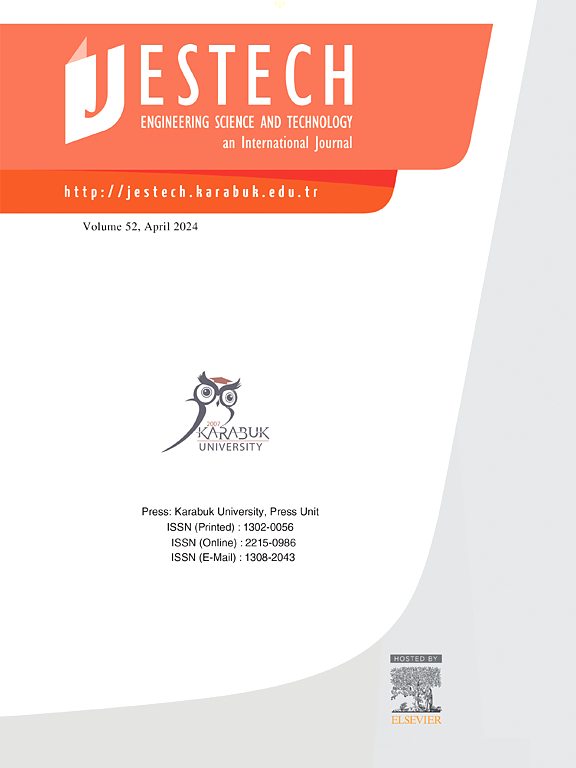基于压电效应的开关电源滤波元件建模与性能评价
IF 5.1
2区 工程技术
Q1 ENGINEERING, MULTIDISCIPLINARY
Engineering Science and Technology-An International Journal-Jestech
Pub Date : 2025-04-16
DOI:10.1016/j.jestch.2025.102060
引用次数: 0
摘要
传统的无源电磁干扰(EMI)滤波器通常需要使用高电感值的共模扼流圈,以确保开关电源(smps)符合相关的电磁兼容性(EMC)标准。这种方法不仅增加了smps的重量和尺寸,而且降低了它们的功率密度。为了解决这些问题,本文提出了一种基于压电效应的smps滤波元件建模和性能评估方法。压电滤波元件在谐振频率下具有低阻抗特性,而在谐振频率外,其阻抗与电容器相似。因此,pfc不仅可以作为无源EMI滤波器中使用的传统干扰抑制电容器(例如y型电容器)的替代品,还可以有效地抑制特定频率下的干扰峰值。基于pfc的阻抗特性,提出了一种谐振频率设计模型。该模型可以通过调整pfc的形状和尺寸来精确调谐pfc的多个谐振频率,从而利用pfc的谐振特性来选择性地抑制smps中多个特定频率的干扰峰。本文将pfc应用于反激变换器,研究了其传导EMI抑制效果。测量结果显示,与y型电容相比,pfc使无源EMI滤波器的重量和体积分别减少了88.72%和90.71%。实验结果表明,基于本文建立的模型,使用PFCs作为滤波元件可以实现更轻、更紧凑的滤波器设计。本文章由计算机程序翻译,如有差异,请以英文原文为准。
Modeling and performance evaluation of filtering components for switch-mode power supplies based on piezoelectric effect
Traditional passive electromagnetic interference (EMI) filters typically need to use common-mode chokes with high inductance values to ensure that switch-mode power supplies (SMPSs) meet relevant electromagnetic compatibility (EMC) standards. This approach not only increases the weight and size of SMPSs but also reduces their power density. To address these issues, this article proposes a method for modelling and performance evaluation of filtering components for SMPSs based on piezoelectric effect. Piezoelectric filtering components (PFCs) possess low impedance properties at their resonant frequency, while outside of resonance, their impedance is similar to that of a capacitor. As a result, PFCs can not only serve as replacements for traditional interference suppression capacitors (e.g., Y-capacitors) used in passive EMI filters but also effectively suppress interference peaks at specific frequencies. Based on the impedance properties of PFCs, this article proposes a resonant frequency design model. This model can precisely tune the multiple resonant frequencies of PFCs by adjusting their shapes and sizes, thereby leveraging the resonant properties of PFCs to selectively suppress interference peaks at multiple specific frequencies in SMPSs. This article applies the PFCs to the flyback converter and investigates their conducted EMI suppression effectiveness. According to the measurement results, compared to the Y-capacitors, the PFCs reduce the weight and volume of the passive EMI filter by 88.72% and 90.71%, respectively. The experimental results indicate that, based on the model developed in this article, using PFCs as a filtering component can lead to a lighter and more compact filter design.
求助全文
通过发布文献求助,成功后即可免费获取论文全文。
去求助
来源期刊

Engineering Science and Technology-An International Journal-Jestech
Materials Science-Electronic, Optical and Magnetic Materials
CiteScore
11.20
自引率
3.50%
发文量
153
审稿时长
22 days
期刊介绍:
Engineering Science and Technology, an International Journal (JESTECH) (formerly Technology), a peer-reviewed quarterly engineering journal, publishes both theoretical and experimental high quality papers of permanent interest, not previously published in journals, in the field of engineering and applied science which aims to promote the theory and practice of technology and engineering. In addition to peer-reviewed original research papers, the Editorial Board welcomes original research reports, state-of-the-art reviews and communications in the broadly defined field of engineering science and technology.
The scope of JESTECH includes a wide spectrum of subjects including:
-Electrical/Electronics and Computer Engineering (Biomedical Engineering and Instrumentation; Coding, Cryptography, and Information Protection; Communications, Networks, Mobile Computing and Distributed Systems; Compilers and Operating Systems; Computer Architecture, Parallel Processing, and Dependability; Computer Vision and Robotics; Control Theory; Electromagnetic Waves, Microwave Techniques and Antennas; Embedded Systems; Integrated Circuits, VLSI Design, Testing, and CAD; Microelectromechanical Systems; Microelectronics, and Electronic Devices and Circuits; Power, Energy and Energy Conversion Systems; Signal, Image, and Speech Processing)
-Mechanical and Civil Engineering (Automotive Technologies; Biomechanics; Construction Materials; Design and Manufacturing; Dynamics and Control; Energy Generation, Utilization, Conversion, and Storage; Fluid Mechanics and Hydraulics; Heat and Mass Transfer; Micro-Nano Sciences; Renewable and Sustainable Energy Technologies; Robotics and Mechatronics; Solid Mechanics and Structure; Thermal Sciences)
-Metallurgical and Materials Engineering (Advanced Materials Science; Biomaterials; Ceramic and Inorgnanic Materials; Electronic-Magnetic Materials; Energy and Environment; Materials Characterizastion; Metallurgy; Polymers and Nanocomposites)
 求助内容:
求助内容: 应助结果提醒方式:
应助结果提醒方式:


